|
|
 |
Fiche d'espèce de Copépode |
|
|
Calanoida ( Ordre ) |
|
|
|
Diaptomoidea ( Superfamille ) |
|
|
|
Acartiidae ( Famille ) |
|
|
|
Acartia ( Genre ) |
|
|
|
Euacartia ( Sous-Genre ) |
|
|
| |
Acartia (Euacartia) southwelli Sewell, 1914 (F,M) | |
| | | | | | | Ref.: | | | Sewell, 1914 a (p.244, figs.F,M); Steuer, 1923 (p.14, figs.F,M); Sewell, 1924 (p.790, fig.F); 1932 (p.393, Rem.); 1948 (p.324, Rem.); Kasturirangan, 1963 (p.64, figs.F,M); Abraham, 1970 (p.52, Rem.); Silas, 1972 (p.650); Goswami & Goswami, 1978 (p.111, figs.); Madhupratap & Haridas, 1994 (p.67, Redescr., figs.F,M); Barthélémy, 1999 (p.858, 864, figs.F); 1999 a (p.9, Fig.26, A-E); Soh & al., 2013 (p.718, Rem.p.723, Table 1, 2, fig.7, 9: chart). | 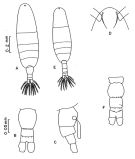 issued from : M. Madhupratap & P. Haridas in Hydrobiologia, 1994, 292/293. [p.69, Fig.1] Female: A, habitus (dorsal view); B, urosome (dorsal), (spinules show variability); C, urosome (right lateral side); D, head with rostral filaments (ventral). Male: F, urosome (dorsal). 20 females and 10 males from the Tuticorin (8°56'N, 78°20'E) and 100 females and 50 males from Portonovo (11°52'N, 79°50'E°E)6), plus specimens from Cochin backwaters (10°N, 76°E), Mandovi-Zuari estuaries (15°30'N, 74°E). Nota female: - Prosome-urosome ratio 3.7 : 1. Cephalosome and pediger 1 separate. -Posterior corners of metasome rounded, naked. - All urosomal somites usually naked. Fine spinules shown on urosomal somites (fig.1B), and male (fig.1F) present only in specimens from Portonovo; the number of spinules varies within this population; specimens examined from other localities without spinules on urosomal somites.; however, spinules may be present on the urosome somites of animals from other localities (Tranter & Abraham, 1971, have shown the female from Cochin possessing some spinules. - Caudal rami symmetrical, 1.4 times longer than broad, bearing 5 plumose setae and 1 setule. Urosomal segments and caudal rami with proportions 46 : 19 : 12: 23 = 100. Nota male: - Prosome-Urosome ratio 3.1 : 1. - Posterior corners of pediger 5 naked. - Urosomal segments also unusually unarmed (variability shown in fig.1F) - Caudal rami nearly as broad as long. - Proportions of urosomal segments and caudal rami 11 : 29 : 23 : 8 : 12 : 17 = 100.
|
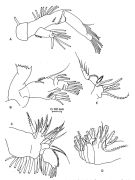 issued from : M. Madhupratap & P. Haridas in Hydrobiologia, 1994, 292/293. [p.71, Fig.3]. Female: A, A2; B, Md; C, Mx1; E, Mxp. Nota: - A2: coxa with 1 single seta,; basis fused with an endopod segment (allobasis) bearing 8 setae at inner margin, 1 seta terminally and 2 distal spinule rows, 2nd and 3rd segments incompletely fused appearing as a bilobed segment each bearing 7 setae; exopod 4-segmented segments incompletely fused (setal formula: 1, 1, 3, 3). - Md: gnathobase with 5 sharp and 4 blunt teeth; basis with 1 medial seta; endopod with 2 incompletely fused segments, 1st with 2 setae, 2nd with 9 setae; exopod partly fused with basis, 3-segmented (setal formula 1, 1, 4). - Mx1: praecoxal arthrite with 8 spines like and 1 weak setae; coxal endite with 2 setae, coxal epipodite with 9 developed setae; each of 2 basal endites with 1 thick seta, basal exite with 1 seta; endopod and exopod incompletely fused with 5 and 2 setae each. - Mx2: praecoxa and coxa with 2 endites each (setal formula 4, 2, 2, 3); basis with 1 large and 1 small seta; endopod 3-segmented (setal formula 1, 2, 4). - Mxp: praecoxa and coxa fused bearing 5 setae; basis bearing 1 spine like seta; endopod 4-segmented, 1st 3 segments incompletely fused, with 1 seta each; terminal segment with 2 setae; - Mouthparts of male as in female.
|
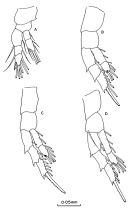 issued from : M. Madhupratap & P. Haridas in Hydrobiologia, 1994, 292/293. [p.72, Fig.4]. Female: A-D, swimming legs 1-4 (respectively).
|
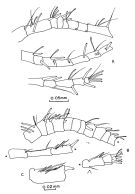 issued from : M. Madhupratap & P. Haridas in Hydrobiologia, 1994, 292/293. [p.70, Fig.2]. Female: A, A1 (proximal segments, middle segments and distal segments, respectively); Male: right A1 (proximal segments, middle segments and distal segments, respectively); C, segment 14 of right A1. Nota: - A1 female 20-segmented, reaching midlength or pediger 5. Segment 4 with 1 spine, segment 8 longest, segments 6, 7, 11, 12, 14, 15 with spinules, terminal segment with 4 setae and 1 aesthetasc. - Right A1 male 18-segmented, suture between segments 15 and 16 incomplete (arrow head, fig.2B), 2spines present on anterior margin of segment 4, 1 spine each on segments 7 and 12, segments 5 and 6 unarmed, geniculation between segments 13 and 14, segment 14 (fig.2C) armed with 2 larger and 2 smaller spines, 1 seta and 1 aesthetasc.
|
 issued from : M. Madhupratap & P. Haridas in Hydrobiologia, 1994, 292/293. [p.73, Fig.5]. Female: A, P5. Male: B, P5. Nota: - P5 female: symmetrical; 3-segmented, both coxal segments fused; basis oblong with 1 small seta on outer margin at about distal 2/3; base of terminal segment slightly swollen, tapering distally, with a distinct suture at midlength, portion distal to suture serrate. -P5 male: Right and left coxal segments fused. Right leg basis with seta at distolateral corner; 1st exopodal segment with 1 long slender seta, 2nd exopodal segment with an oblong inner lobe bearing 1 spine, 3rd segment curved with 1 thick spine at midlength on medial margin and another at tip. Left leg basis more than twice as long as broad with outer seta at midlength; 1st exopoal segment short and unarmed, terminal segment medial margin with proximal tuft of hair, 1 spine embedded in a membraneous sheath, the sheath produced and of irregular shape and flanked on distal side by a recurved spine; tip of segment bifurcate, outer process much longer than inner process.
|
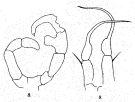 Issued from : R.B.S. Sewell in Spolia Zeylanica, 1914, 9. [Pl.XIX, Figs.8-9]. Female (from Gulf of Mannar): 9, P5. Nota: Head and 1st thoracic segment separate, 4th and 5th fused. Posterior thoracic margin rounded and devoid of spines. Forehead with a pair of slender curved rostral filaments. Proportional lengths of prosome and urosome 35:1. Proportional lengths of urosomites and furca 26:13:10:15; all segments devoid of any spines. Caudal rami nearly as wide as long (9:10). A1 20-segmented (segments 2-4, 5-6, 7-8, 9-10 fused) reach just beyond the posterior thoracic margin. P5 consist of a fairly long basal segment bearing 1 minute seta on its external margin distally, and having a long and delicate terminal spine, this spine is curved and has a markedly swollen base. Male: 8, P5. Nota: Proportional lengths of prosome and urosome 4:1. Proportional lengths of urosomites and furca 18:14:3:9:10. Right A1 15-segmented (segments 1-4, 5-6, 7-8, 19-21, 22-25 fused) modified to form a grasping organ. P5: the right leg forms a claw, the 2nd segment bears a somewhat quadrangular process on its inner border, and the 3rd segment terminates in 2 short unequal spines.
|
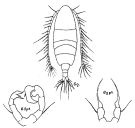 issued from : R.B.S. Sewell in Fauna of the Chilka Lake, 1924, 12. [Pl. XLV, Fig.6]. Female and Male (from Chilka Lake).
|
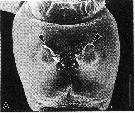 issued from : R.-M. Bathélémy in J. Mar. Biol. Ass. U.K., 1999, 79. [p.864, Fig.7, A]. Scanning electon miccrograph. Female from Indian Ocean): A, genital double-somite (ventral); Note the epicuticule (arrowheads) covering the genital slits except the copulatory field (arrows). Scale bar: 0.020 mm.
|
 Issued from : H.Y. Soh, S.Y. Moon, E.O. Park & B.A.V. Maran in J. Crustacean Biol., 2013, 33 (5). [p.727, Table 1]. Comparison of morphological features between A. forticrusa and its congeners A. southwelli and A. sarojus
| | | | | Ref. compl.: | | | Subbaraju & Krishnamurphy, 1972 (p.25, 26 ); Patel, 1975 (p.660); Ohtsuka & al., 1995 (p.158: Rem., 159); Madhupratap & Haridas, 1986 (p.105, tab.2); Gajbhiye & Abidi, 1993 (p.137); Godhantaraman, 1994 (tab.5, 6, 7); Mauchline, 1998 (tab.8); Madhu & al., 2007 (p.54, Table 4, abundance vs monsoon); Fernandes, 2008 (p.465, Tabl.2); Rakhesh & al., 2008 (p.154, abundance vs stations); Shanthi & Ramanibai, 2011 (p.132, Table 1); Drillet & al., 2012 (p.155, Table 1, culture); Rakhesh & al., 2013 (p.7, Table 1, abundance vs stations); Varadharajan & Soundarapandian, 2013 (p.2: occurrence vs stations) | | | | NZ: | 2 | | |
|
Carte de distribution de Acartia (Euacartia) southwelli par zones géographiques
|
| | | | | | | | |  issued from : C.T. Achuthankutty, N. Ramaiah & G. Padmavati in Pelagic biogeography ICoPB II. Proc. 2nd Intern. Conf. Final report of SCOR/IOC working group 93, 9-14 July 1995. Workshop Report No. 142, Unesco, 1998. [p.8, Fig.6]. issued from : C.T. Achuthankutty, N. Ramaiah & G. Padmavati in Pelagic biogeography ICoPB II. Proc. 2nd Intern. Conf. Final report of SCOR/IOC working group 93, 9-14 July 1995. Workshop Report No. 142, Unesco, 1998. [p.8, Fig.6].
Salinity ranges for A. southwelli in coastal and estuarine waters of Goa (India).
Shaded area indicates the range of higher abundance. |
| | | | Loc: | | | India ( Saurashtra coast, S, Cochin, Kerala, Porto Novo, G. of Mannar, Sri Lanka Pearl Banks, Pointcalimere-Mallipattinam, Godavari estuary & coastal, Kakinada Bay, Chilka Lake), Bay of Bengal, China Seas (Bohai Sea) | | | | N: | 19 | | | | Lg.: | | | (44) F: 0,773; M: 0,68; (80) F: 0,726; M: 0,712; (82) F: 0,8; M: 0,75; (186) F: 0,84-0,79; M: 0,75-0,7; {F: 0,726-0,84; M: 0,68-0,75} | | | | Rem.: | estuaire-néritique.
Les tailles semblent corrélées avec la salinité. 15 à 35 p.1000 in Cochin and the Mandovi-Zuari estuaires
W. Zhang confirme la présence de cette espèce dans les mers de Chine (comm. pers., 2006).
Voir aussi les remarques en anglais | | | Dernière mise à jour : 06/06/2020 | |
|
|
 Toute utilisation de ce site pour une publication sera mentionnée avec la référence suivante : Toute utilisation de ce site pour une publication sera mentionnée avec la référence suivante :
Razouls C., Desreumaux N., Kouwenberg J. et de Bovée F., 2005-2025. - Biodiversité des Copépodes planctoniques marins (morphologie, répartition géographique et données biologiques). Sorbonne Université, CNRS. Disponible sur http://copepodes.obs-banyuls.fr [Accédé le 28 novembre 2025] © copyright 2005-2025 Sorbonne Université, CNRS
|
|
 |
 |











